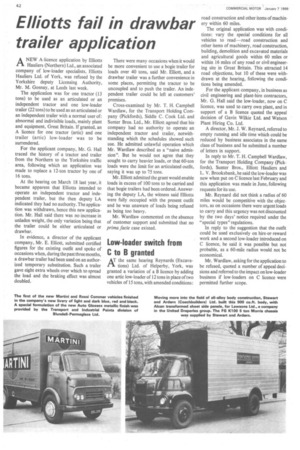Elliotts fail in drawbar trailer application
Page 44

If you've noticed an error in this article please click here to report it so we can fix it.
ANEW A licence application by Elliotts Hauliers (Northern) Ltd., an associated company of low-loader specialists, Elliotts Hauliers Ltd. of York, was refused by the Yorkshire deputy Licensing Authority, Mr. M. Gosnay, at Leeds last week.
The application was for one tractor (13 tons) to be used as an articulated or an independent tractor and one low-loader trailer (22 tons) to be used as an articulated or an independent trailer with a normal user of: abnormal and indivisible loads, mainly plant and equipment, Great Britain. If granted, an A licence for one tractor (artic) and one trailer (artic) low-loader was to be surrendered.
For the applicant company, Mr. G. Hall traced the history of a tractor and trailer from the Northern to the Yorkshire traffic area, following which an application was made to replace a 12-ton tractor by one of 16 tons.
At the hearing on March 18 last year, it became apparent that Elliotts intended to operate an independent tractor and independent trailer, but the then deputy LA indicated they had no authority. The application was withdrawn, hence this new application. Mr. Hall said there was no increase in unladen weight, the only variation being that the trailer could be either articulated or drawbar.
In evidence, a director of the applicant company, Mr. E. Elliott, submitted certified figures for the existing outfit and spoke of occasions when, during the past three months, a drawbar trailer had been used on an authorized temporary substitution. Such a trailer gave eight extra wheels over which to spread the load and the braking effect was almost doubled. There were many occasions when it would be more convenient to use a bogie trailer for loads over 40 tons, said Mr. Elliott, and a drawbar trailer was a further convenience in some places, permitting the tractor to be uncoupled and to push the trailer. An independent trailer could be left at customers' premises.
Cross-examined by Mr. T. H. Campbell Wardlaw, for the Transport Holding Company (Pickfords), Siddle C. Cook Ltd. and Sunter Bros. Ltd., Mr. Elliott agreed that his company had no authority to operate an independent tractor and trailer, notwithstanding which the schedules showed such use. He admitted unlawful operation which Mr. Wardlaw described as a "naive admission". But he would not agree that they sought to carry heavier loads, or that 60-ton loads were the limit for an articulated outfit, saying it was up to 75 tons.
Mr. Elliott admitted the grant would enable loads in excess of 100 tons to be carried and that bogie trailers had been ordered. Answering the deputy LA, the witness said Elliotts were fully occupied with the present outfit and he was unaware of loads being refused as being too heavy.
Mr. Wardlaw commented on the absence of customer support and submitted that no prima facie case existed.
Low-loader switch from C to B granted
AT the same hearing Reynards (Excavations) Ltd. of Helperby, York, was granted a variation of a B licence by adding one artic low-loader of 12 tons in place of two vehicles of 15 tons, with amended conditions: road construction and other items of machinery within 60 miles.
The original application was with conditions: vary the special conditions for all vehicles to read—road construction and other items of machinery, road construction, building, demolition and excavated materials and agricultural goods within 60 miles or within 16 miles of any road or civil engineering site in Great Britain. This attracted 14 road objections, but 10 of these were withdrawn at the hearing, following the conditions being amended.
For the applicant company, in business as civil engineering and plant-hire contractors, Mr. G. Hall said the low-loader, now on C licence, was used to carry own plant, and in support of a B licence quoted the appeal decision of Gavin Wilkie Ltd. and Watson Plant Hiring Co. Ltd.
A director, Mr. J. W. Reynard, referred to empty running and idle time which could be reduced by business associates in the same class of business and he submitted a number of letters in support.
In reply to Mr. T. H. Campbell Wardlaw, for the Transport Holding Company (Pickfords), Sunter Bros., Elliott Hauliers and L. V. Brooksbank, he said the low-loader was new when put on C licence last February and this application was made in June, following requests for its use.
Mr. Reynard did not think a radius of 60 miles would be competitive with the objectors, as on occasions there were urgent loads to carry and this urgency was not discounted by the two days' notice required under the "special types" regulations.
In reply to the suggestion that the outfit could be used exclusively on hire-or-reward work and a second low-loader introduced on C licence, he said it was possible but not probable, as a 60-mile radius would not be economical.
Mr. Wardlaw, asking for the application to be refused, quoted a number of appeal decisions and referred to the impact on low-loader business if low-loaders on C licence were permitted further scope.




















































































































